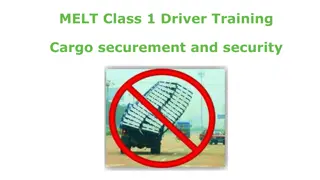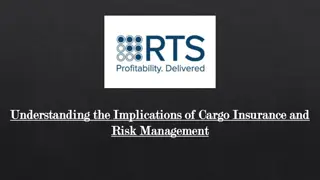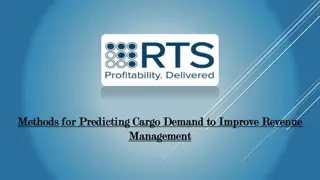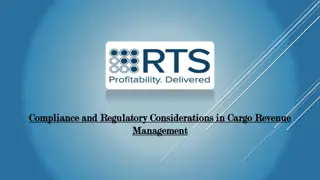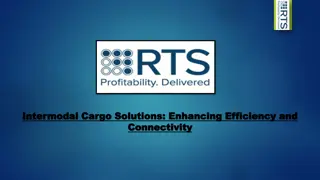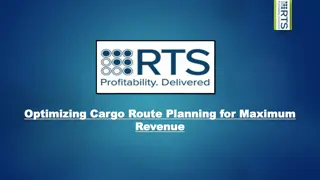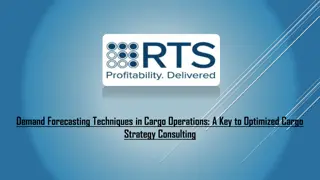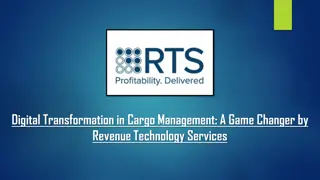Understanding Costs for Removing Lost Cargo in Marine Insurance
This presentation by Professor Satoshi Nakaide from Waseda University delves into the complexities and importance of resolving issues related to removing damaged cargo at sea. The content covers the urgency, difficulties, legal aspects, and various tests involved in such cases. It emphasizes the need for case-specific examination to determine liability and costs, considering factors like nature of damage, cargo value, and insurance coverage.
Download Presentation

Please find below an Image/Link to download the presentation.
The content on the website is provided AS IS for your information and personal use only. It may not be sold, licensed, or shared on other websites without obtaining consent from the author. Download presentation by click this link. If you encounter any issues during the download, it is possible that the publisher has removed the file from their server.
E N D
Presentation Transcript
Costs for Removing Lost Cargo: Cargo or P&I ? Satoshi Nakaide Professor, Waseda University LLM(London), Diploma(Cambridge) nakaide@waseda.jp Marine Insurance WP 30 September, 2014 Rome
Photo is provided by Mr. Miyahiro, Japan P&I Club. Copy is not allowed. 2
Outline of the Presentation Outline of the Presentation Importance of the Issue Difficulties of the legal Issue Tests Case Study 1 Case Study 2 Case Study 3 Case Study 4 Summary 3
1. Importance of the Issue 1. Importance of the Issue Seriousness Often the issue becomes a big issue involving wide range of people. Urgency The issue is often an urgent matter. Any delay further worsens the situation. Difficulties of Adjusting Conflicting Interests Removing damaged cargo involves a greater cost than the value of cargo. Nobody wants to bear the cost. 4
2. Difficulties of the Law on the Issue 2. Difficulties of the Law on the Issue Various Situations Situation varies case to case. - nature and quantity of the cargo - seriousness of the damaged cargo - place of the damaged cargo - parties involved - insured or not insured Any generalization may be misleading Disclaimer: Each case must be examined based on its actual situation. Today s presentation is aimed at providing a brief guidance based on my personal understandings. 5
3. Tests to be Considered (1) 3. Tests to be Considered (1) Q1 Nature, seriousness of damage and quantities of cargo - perishable - dangerous - oil - volume of the damaged cargo Q2 Is the damaged cargo on board the vessel? ex. sea water damage of corns onboard ex. round logs washed over board Q3 Is the value of the damaged cargo more than the removal costs? Q4 Where is the damaged cargo? - in the high seas, territorial waters, port, - on land public beach, private place, road, river 6
Tests to be Considered (2) Tests to be Considered (2) Q5 Cause of the damage of the cargo - negligence of the ship owner or operator - dangerous nature of the damaged cargo itself - force majeure Q6 Does the vessel need removal, too? Q7 Are the cargo and vessel insured for its liability? - special cover for cargo owner against removal liability <rare> - P&I insurance of ship owner for cargo indemnity Is the premium paid? 7
4. Case Study (1) 4. Case Study (1) * Hypothetical case Case: Vessel with cargo sank in the shallow water and both became total loss. Ship owner is a member of Japan P&I. Issues involved: - Whether the cargo need to bear the part of removal costs or not? Possible solution: My Personal View - As far as the cost of removing ship only, i.e. where ship needs to unload the damaged cargo, is higher than the costs of removing both, P&I may bear the cost. The cost will be regarded as reasonable. - Even if ship owner asks cargo owner to contribute to the removal costs, cargo owner will resist its payment, asserting ship owner's responsibility for the accident. 8
Case Study (1) Case Study (1) * Hypothetical case Question?: How will be the apportionment if the removal costs becomes greater because of the nature of the cargo, such as the dangerous nature of the cargo? Possible solution: My Personal View - If there is not any justifiable logic for the ship owner to bear the whole cost, P&I may not be able to bear the whole costs. Cargo owner need to bear the part of the cost increased solely by the nature of the cargo. - Cargo owner may resist its payment, asserting ship owner's responsibility for the accident. The liability will be judged on the terms of the carriage contract. 9
5. Case Study (2) 5. Case Study (2) * Hypothetical case Case: Wheat on the vessel were totally lost because of the sea water entered into the hold from the hatch cover during the heavy weather. Issues involved: - Who should pay the cost of removing cargo from the ship and damping it, so far as the cargo owner waives his right of property? Possible solution: My Personal View - The vessel needs to unload the cargo as usual although it may incur extra charge. - Cargo owner need to damp the cargo and bear the extra charge for it. The cost are not covered by his cargo policy. - Cargo owner may claim compensation against the ship owner for his loss caused by the vessel under the relevant carriage contract up to the limit of the carriage contract. - If the liability of ship owner of charter is established, relevant P&I club will pay the insurance money for it under her cargo indemnity cover. 10
6. Case Study (3) 6. Case Study (3) * Hypothetical case Case: Round logs imported to Japan were washed over board and were drifted to the beach. Ship owner is a member of Japan P&I. Issues involved: (a) Ownership of the damaged cargo - Who is the owner of the property .. seller or buyer? (b) Transfer of property under marine cargo policy - Is the cargo owner entitled to abandon the cargo to the cargo insurer as it is totally lost under its marine cargo policy with ICC? Can insurer refuse the transfer of it? - Does the property transfer from cargo owner to its insurer after his payment for total loss based on Art. 24 of the Japanese Insurance Contract Act? Can insurer reject its transfer? 11
Case Study (3) Case Study (3) * Hypothetical case Issues involved: (c) Liability for the accident - Is the ship owner responsible for the accident? - Is the owner entitled to limit his liability under the carriage contract? (d) Liability for the removal costs - What law and regulation apply to the case? 12
Case Study (3) Case Study (3) * Hypothetical case Possible Solution : my personal view - Transfer of ownership arises based on the contract of sale between the seller and its buyer irrespective of the terms of the INCOTERMS. - In many cases, the buyer will be the owner of the cargo after the payment for the cargo. - Cargo insurer will be entitled to reject accepting transfer of property against the notice of abandonment from the assured under the English Institute Cargo Clauses 2009. - Cargo insurer will be entitled to reject the legal transfer of the damaged property under the Japanese Insurance Act Art. 24. 13
Case Study (3) Case Study (3) * Hypothetical case Possible Solution : my personal view - Liability of its removal will arise based on various laws and regulations. Ex: Port Regulation Law, Port and Harbor Law, Maritime Traffic Safety Law, The Law about Prevention of Maritime Disasters, such as Sea Pollution, The Law on the Sea Coast, Law on the Natural Parks, Wastes Disposal and Public Cleaning Law Various regulations of the local authorities Right of claim for removing obstacle under the Civil Code . - The party responsible for the removal costs will be judged by the applicable law and regulations. ex: ship owner, party responsible for the accident 14
Case Study (3) Case Study (3) * Hypothetical case Possible Solution : my personal view In reality, - - Immediate removal of the cargo will be needed. In many cases, the name of the vessel will be reported by the mass media. However, its is rare that the name of the cargo owner is disclosed. It may not be easy for the public to know the various cargo owners of the damaged cargo. Ordinary persons will consider that the shipping company which caused the accident should be responsible for the removal costs. Local authority may ask the ship owner and its P&I and in many cases actually issues a formal order to remove the logs. Ship owner may not be able to prove that he has no fault about the accident. P&I may bear the removal costs as far as there is a formal order by the authority against the ship owner to remove the cargo and cargo owner abandons the property. - - - - 15
7. Case Study (4) 7. Case Study (4) Case: Many vessels, some with cargo, were drifted and grounded on land and became total loss because of the huge Tsunami after the large earthquake of 11 March 2011 in Japan. Number of damaged vessels fishing boats 19,811 vessels other than fishing boats vessels less than 20 GT 15,500 more than 20 GT 57 * base on the figure of Ministry of Land, Infrastructure, Transport and Tourism Bureau of Shipping, 2011 16
Photo is provided by Mr. Miyahiro, Japan P&I Club. Copy is not allowed. 17
Case Study (4) Case Study (4) Various places of the damaged property - Ocean, Port, Coast, Park, River, Road, Private place - Liability of its removal will arise based on various laws and regulations. Ex: Port Regulation Law, Port and Harbor Law, Maritime Traffic Safety Law, The law about Prevention of Maritime Disasters, such as Sea Pollution, The Law on the Sea Coast, Law on the Natural Parks, Law on the River, Wastes Disposal and Public Cleaning Law Various regulations of the local authorities Right of claim for removing obstacle under the Civil Code . 18
Case Study (4) Case Study (4) Legal Issues - Does P&I insurance cover Tsunami risk of the earthquake? - Does P&I insurance cover removal costs on land? - Can P&I Club recover the part of removal cost from the cargo? Difficulties - It was not easy to find the owner of the damaged cargo as they were mingled with other properties such as house, warehouse, etc. However, owner of the large ships were easily identified by the name stated on the vessel. 19
Case Study (4) Case Study (4) Solution : - Immediate removal of the wreck was needed. - Authorities noted the fact that Tsunami risk was not excluded from the P&I insurance and asked P&I to bear the removal costs of the merchant vessels covered by the P&I insurance. - As to the cargo vessels, the relevant authorities made orders against the ship owners to remove the vessel including its cargo. to be continued 20
Case Study (4) Case Study (4) Solution : - Theoretically, the ship owners might have been able to ask its cargo owner if any to bear the part of the removal cost, insisting that the accident was caused by the force majeure and the expenses include those of the removal of cargo. However, as far as the removal order is against the ship owner, it was not easy for the ship owner to establish his right of claim against the cargo owner under the contract of carriage. It is not easy for the ship owner to prove that he has paid every reasonable measure to prevent such a drifting. - P&I insurance does not exclude the risk of tsunami or earthquake and it may not be easy to deny claim from the ship owner to bear the removal costs, so far as there is in fact a formal order by the authority against the ship owner to remove the vessel with cargo. 21
8. Tentative Solutions under Japanese Law 8. Tentative Solutions under Japanese Law Personal View (1) Cargo on board the vessel If the cargo owner wants to obtain it, cargo owner will bear the cost of the removal of cargo. Where the carrying vessel is also a wreck and it is reasonable to remove both of the ship and cargo together, P&I Club may bear the whole of the removal costs. (2) Cargo outside the vessel It is controversial. However, in reality, ship owner and its P&I will bear the removal cost of removing cargo under its indemnity cover, unless the ship owner may well establish that he owes no liability for the accident. (3) Costs increased by the nature of the cargo Increased cost caused by the nature of cargo, such as the dangerous nature of cargo, should be born by the cargo owner. 22
9. Conclusions 9. Conclusions Difficult area of laws Law is not clear. Immediate removal is necessary and it may not be wise to bring the matter into court. If the ship owner tries to lesser its burden by bringing the matter into court, ship owner will face serious reputational risk. In reality, P&I Club works very efficiently and settle the matter nicely among conflicting interests. Thank you for listening ! The END 23







